
学过A-Level经济的宝宝们大多都认为,宏观经济部分的的难度是要高于微观,事实确实是这样,不过只要我们能够准确理解各个概念和知识点,平时多看书,多总结笔记和相关题目,其实宏观部分也没那么难。
今天就为大家送上宏观经济部分必须要掌握的概念,需要的宝宝们快快收藏吧!
Macroeconomic Definitions
Actual GDP Growth: Actual GDP growth is the growth in real GDP that currently occurs.
Aggregate Demand: Aggregate demand (AD) is the total amount of expenditure on goods and services in an economy.
Aggregate Supply: Aggregate supply is the total amount of supply of goods and services in an economy.
Balance of Payments: The balance of payments (BoP) is a record of all external financial transactions between one economy and the rest of the world.
Boom: A boom occurs if there is a major and rapid increase in real GDP.

Business Cycles: Business cycles are the pattern of booms and recessions in an economy over a period of time. Business cycles are the fluctuation of real GDP around the long-term trend growth rate.
Circular Flow of Income: A model of the economy that shows how households sell their labour to firms for an income and then use this income to buy goods and services produced by firms.
Claimant Count: A measure of unemployment, anyone claiming unemployment benefit is defined as unemployed by the claimant count.
Consumer Price Index (CPI): The CPI is a measure of inflation. The CPI is a price index of a weighted basket of goods and services that the average household buys.
Consumption: Consumption is total consumer expenditure on durables, non-durables and services.
Contractionary Fiscal Policy: A contractionary fiscal policy means so AD falls. Multiplier effects make AD fall further. AD shifts left so inflation falls and real GDP falls.
Cost-Push Inflation: Cost-push inflation occurs when LRAS shifts left because resource prices rise or wages rise, firms’ costs rise and their prices rise.
Credit Crunch: A situation where banks and other financial institutions decrease their lending or stop lending altogether.
以上是部分的要详细版可直接找老师哦~

